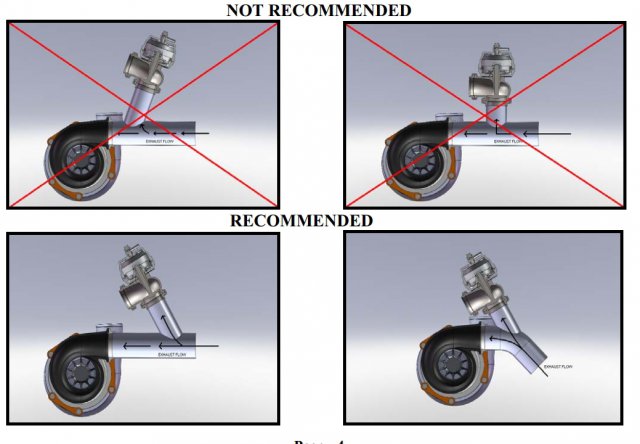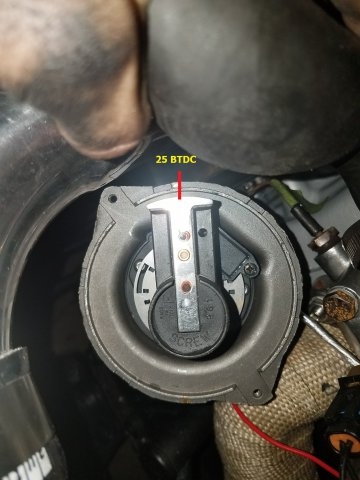-
Posts
1051 -
Joined
-
Last visited
-
Days Won
9
Content Type
Profiles
Forums
Blogs
Events
Gallery
Downloads
Store
Everything posted by Chickenman
-
Look up Softopz on the Vendors forum. He builds MS2 units and a beautiful plug and play harness.
-
Can you post up a wide angle shot of your W/gate manifold and exhaust setup? Proper angles of W/Gate inlet pipes and outlet pipes can make a huge difference to W/gate efficiency as noted above. Right angles and reverse angles are bad.
-
Before you buy anything else. Try putting a lighter Wastegate spring in. The 9.4 lb spring may not be allowing the W/G poppet valve to open 100%. Try a spring combo with a 7 lbs rate. You can go all the way down to a 3 lbs if you need to. If you have any restrictions to W/Gate flow ( bad entry angles for example ) then you may have to use a lighter spring combo than necessary to get the Valve opening more. Simply because the exhaust flow to the W/Gate is not optimal. W/Gate positioning and entry angles for exhaust play a big part in controlling Boost. Get them wrong and the W/Gate will be inefficient
-

Anyone used 1999-2001 Jetta/Golf wasted spark logic coil drivers?
Chickenman replied to turbogrill's topic in Nissan L6 Forum
Pretty sure they use the BIP373 coil driver. -

Anyone used 1999-2001 Jetta/Golf wasted spark logic coil drivers?
Chickenman replied to turbogrill's topic in Nissan L6 Forum
There's a thread on that Coil Pack on the MSExtra MS2 forum. I'll have to dig around a bit to find the link. You may be better of with WS Dodge ( Mitsubishi brand ) coils or the Ford Escort TFI Coil Packs. Very powerful coil packs. -
Wow... Desktop Dyno... I haven't played with that in ages. It worked out well when choosing cams for my Autocross/ Hillclimb 355ci SBC. I think my latest version is Desktop Dyno 2000. I'll have to see if I can load it up on my Windows 7 machine.
-
Wow... that's an old Unit. I thought my E11-V1 was old. Attach your current Tune and setup to a reply here and I can have a look at it with HalWin.
-
Well... I can't answer the second question. But yes the Rotor is held on with a small Metric screw. It's a Phillips head and I think it's an M5 if memory serves me correct.
-
Kinda wondering why you didn't go with a T3/T4 Hybrid? T4 compressor with T3 exhaust housing. That's a pretty standard setup. T4 exhaust housing may be pretty laggy....
-
This is the way it should be done. T3 to T4 adapter
-
Hmmmm... I just don't see how that the Turbo flange gasket is going to seal with those Allen head bolts recessed like that. The gasket is going to blow out on that thin little sealing edge left on the outside of the Allen head bolts. Good luck, but I don't think that will work very well???
-
With the Turbo dizzy and shaft, you do not need either of those parts. The Turbo dizzy bolts directly to the timing cover. Make sure you have the gasket that goes between the dizzy and timing cover. Latest part number from Nissan is 22179-29N00. A new non -Nissan gasket came with my A1-Cardone distributor.
-
Shane... we may have to alter the Battery Voltage correction to keep your AFR's more consistent. This is where a big 80 or 90 Amp small frame Alternator has an advantage. An 90 Amp Maxima alternator will crank out 51 amps at 1,000 RPM. The old 70 Amp IR 280Z and ZX alternators can't do that. 60 Amps just won't cut it with Electric Fans and EFI. Most newer style alternators ( since the mid to late 80's ) are a lot more efficient and really pump out the Amps at low RPM's. I absolutely wouldn't consider anything less than 80 amps with EFI and decent electric fans ( 2,500 CFM plus ) .
-
Ball Bearing Turbo's spool so fast these days you can kiss Turbo Lag goodbye. A GT2871R will spool stoopid fast and should be close to the Power you want. Quite a few Autocrossers and Hill climbers out West use GT2871R and there is no boost Lag, Those are mainly 2.0 liter to 2.4 liter though. For over 3.0 liters you may want to look at a GT3071R, GTX3071R Gen -11 or a GTX2867 R Gen-II. Lots of choices from Garret and Borg Warner.
- 5 replies
-
- 280z
- enginer builders
-
(and 4 more)
Tagged with:
-
Not your fault. The text info from DIY is correct. It's just that my picture was for the standard Nissan wiring.... and it's now in Google search!! Could be misleading... If you just want simple Batch fire and a single coil. It will work fine for that. It's just if some people want Waste Spark, COP Ignition or Sequential fueling then they need the other Cam signal. Most people don't know about DIY flipping slot orientation, which also means flipping the Green and White LED output wires on the dizzy side to match the MS ECU inputs. My picture shows the factory Nissan outputs and colors on the dizzy side, which is what Haltech uses.
-
^ Ha Ha ha ... That's my Picture of my personal distributor. Please note the above colors in the picture of my Dizzy are set up for a Haltech. With the DIY L28 Trigger wheel they flip the orientation of the slots from how Nissan originally had it. That flips the functions of the LED's reading the Trigger disk as well. On an MS2 with DIY L28 custom Trigger Wheel, the colors would be. Dizzy side Red = +12v Black = Ground ( To sensor ground in MS ECU ) Green = Cam Trigger ( If you want to use Full sequential Fuel or COP Ignition ) White = Crank Trigger Edit: Also note that the above link ( https://www.diyautotune.com/support/tech/install/nissan-datsun/megasquirt-your-280zx-turbo/ ) is OLD information. That article was written long before DIY made their Custom L28 Trigger wheel. The above instructions were written by " MobyTheVan " I believe, and were a work around for L28 Optical dizzy's because the MS1 and MS2 could not decode the Nissan 360 slot wheel accurately. Note that the above instructions only give you a Basic Trigger system. You need the Cam Trigger to run COP or Full sequential. Unfortunately the MS sites are full of old outdated articles. You have to be very careful what you are reading. That's what happens when you have a platform that has multiple ways of being built and Software covering Multiple ECU's.
-
Yep. That is the correct distributor. Be careful with the Optical Trigger disk. It can be installed upside down and that will mess you up. DIYAutoTuning has pictures of the correct way to install it. Rotor phasing is a step that a lot of people miss, and it is quite important. Here are some instructions and a Picture to help.
-
^ That looks a lot safer than drilling holes and creasting stress risers. You're actually removing stress risers by polishing. Not that I've ever seen a stock Nissan rocker break in two. The " Forge " be strong with these.
-
I'd be worried about stress risers from those drilled holes. How many RPM's are you planning on turning with this engine?
-
The factory used a combination of both as Colten noted. On race cars I switched everything out to studs, as we often had the Intake manifolds off and on. Made the install faster, plus less danger of pulling a thread out of the aluminium. Even the thermostat upper housing had studs. This was after a certain Ham fisted friend/crew managed to over tighten and strip the threads out of the lower thermostat housing. Doh!!! I worked at a Nissan dealership Parts Dept so had plenty of access to high grade Nissan studs. In fact I always made sure that we had lots of the " special " hardware like half-shaft bolts and nuts. It was funny, but the local Metro Vancouver Nissan dealers always had the best supply of high grade fasteners in stock . A lot of the Parts and Service staff Road Raced at WestWood. Most of the shops used Bowman fasteners for their " Standard Fastener" shop supply. I always made sure that the Road salesman always loaded us up on nothing less than the Metric equivalent of Grade 8 or better.
-
I got mine from Rock Auto. A1- Cardone. Was a reasonable price at the time. Do spend some time checking it over. I found the trigger disc was rubbing on the CAS LED. Assembly error from manufacturer. They often use the later Maxima CAS in the 280ZX dizzy. The Maxima CAS has two plastic alignment " Tit's " on the bottom that have to be filed off, so that the Module sits flat on the mounting pad. Also, on the 280ZX dizzy, the 3 mounting screws fro the CAS go in from the top and thread into the dizzy housing. So the 280ZX CAS module has smooth holes in the CAS body and threads in the dizzy body. The Maxima CAS is slightly different. It has threaded " Bosses " in the CAS body and the screws come up from the bottom. Through unthreaded holes in the Maxima dizzy body. When you combine the Maxima CAS with the 280ZX dizzy body, you have two sets of threaded holes. In the CAS module itself and in the 280ZX dizzy body. This doesn't screw together very well. What I did was drill the threads out in the bottom of the 280ZX dizzy. Then I installed the 3 mounting screws from the bottom of the 280zx dizzy housing and into the threaded bosses in the Maxima CAS. That worked perfect. Something to check with Re-man dizzys;.
-
Engine block ground is OK. Just as long as it is a reasonable distance ( 12 inches??? ) away from Starter motor. Starter motor produces a huge amount of EMI when cranking. You don't want a sensitive ECU ground close by. Starter will also induce electrical Eddy currents in the engine block close to the starter. These dissipate with distance.
-
BTW. I just e-mailed Shane Rice ( Op ) and he confirmed that he has indeed switched his ECU ground from the Chassis to the Intake Manifold. Stock Nissan grounding location. So all is good in that respect. I was remote tuning for Shane so this is all relevant to me. And I know some inside details on the setup. The tune worked very well according to Shane. FWIW. The AFR gauge difference all just a calibration issue with the Innovate WB controller. It's not a big issue and is a common problem with Innovate products. Personally, I have personally seen and read about too many issues with Innovate products and would never use one of their products. Innovate apparently shut down there User Support Forums in late 2016. To many negative comments. Is that lame or what?
-
There is a debate by some Standalone ECU manufactures on using an engine ground ( Intake manifold or cylinder head preferred ) , or a ground from the ECU straight to the Battery terminal. IMHO, there should be no debate at all. There are dangers associated with grounding an ECU directly to the Negative Battery cable and those dangers should be discussed. The following is why Nissan, and most OEM manufacturers ( that I have ever seen ), always ground the ECU to the engine Cylinder head or Intake manifold. 1: It reduces the potential to create a Large ground loop. Large ground loops can increase electrical noise in the electrical circuit. ECU's and sensor operate on millivolts and they don't like Electrical noise. Andy Wyatt has a good article on proper ECU grounding procedures. It is a very good article. Andy Whittle who makes DIYAutoTuning videos ( very good videos BTW ) , has covered this same subject on Guild of EFI Tuners before. Their consensus is ground ECU to engine.. for a number of reasons. http://www.adaptronic.com.au/ecu-grounding-tips/ 2: The #1 reason for not connecting the ECU ground directly to the Negative battery cable is what if the Main ground cable to the starter is defective or loose??? ... then you can absolutely FRY your ECU in an instant when you crank the engine over. This happens more often than some people realise. A new starter motor draws between 150 to 200 depending on it's Power rating. That's for a small 4 - 6 cylinder engine... under ideal conditions ( Google it ). That's constant running, once they have gotten the engine spinning. On initial start, momentary draw can easily be 250 to 300 amps on a V8 or High compression 6 cylinder. In freezing temperatures that momentary draw can rise to 500 AMPS!!! That's a hell of a lot of current flowing through that Negative battery Terminal. Think about that for a bit. Out main ground strap bolts directly to the engine block. In most cases to the Top starter mounting bolt that goes through the transmission. Thiis connection has to be 100% perfect and be capable of handling up to 500 amps of momentary current. We also have a small 10 gauge wire that goes from the Negative Battery terminal to the Firewall. That handle maybe 40 to 50 amps maximum What happens if you change the starter or transmission and forget to attach the Negative Battery cable to the engine . Or you leave the top bolt a bit loose. Mistakes happen all the time when it's late and you're tired. Or there's a bit of corrosion, dirt, grease, oil , paint or some other contaminant at the ground location for that Neg battery cable. Or perhaps the cable is old and fayed, or has some corrosion in the eyelet? Happens all the time on Vintage cars. What will happen is that when you crank the engine, the starter is going to pull that 200+ amps through any ground circuit it can. If the starter main ground is not PERFECT... that means that it will pull some or ALL of that amperage through ANY other ground source. That includes the tiny #10 gauge wire to the firewall, throttle cables ( Common for them to catch fire as they get so hot ) or any other ground connected to the Negative Battery cable. And that includes your expensive ECU. There is no denying that. It has happened countless times in the Automotive world and is well documented. That my friends is why I always connect my ECU grounds to the engine. You will not fry the ECU if something bad happens to the starter or the ground cable to the starter. And as I've mentioned over and over. Nissan chose the engine grounding method for the ECU fir very sound engineering reasons. I'm not going to second guess them. Or the hundreds of OEM manufacturers who choose the same method. Personally, I have never seen an OEM manufacturer ground an ECU directly to the Battery. Oh I'm sure that somewhere, sometime an OEM has. And I'm sure " Some guy " will have to dig up an example jst to try and prove otherwise. Just my .02c.
-
Matt" Here is the documentation direct from MS Extra showing proper grounding schemes to the Engine Cylinder Head or Block And repeated by other manufacturers. 3.2 Grounding (Earthing) Schemes Implementing a correct grounding scheme is critical to a successful Megasquirt install. Connecting sensors to the wrong ground, using corroded ground points or dubious original wiring are sure-fire ways to give you a headache. There are two key rules: 1. All sensors must ground at the Megasquirt 2. Ground the Megasquirt at the engine block/head using both available ground wires. Reasoning: When a current flows through a wire there is always a voltage drop, the bigger the current, the bigger the drop (this is ohm's law.) During cranking there is a very large current flowing through the ground strap from battery to engine and perhaps a few volts may be dropped across it. Even during running, a number of amps will flow through the Megasquirt grounds to the engine. The sensors (coolant, air temp, throttle position, wideband, tach input) all use low current, low voltage signals. The Megasquirt measures the voltage from the sensor and converts it into a temperature, position etc. reading. If that sensor is grounded to anything other than the Megasquirt itself, then that input voltage will be altered by any external voltage drops. For a sensitive measurement such as AFR (lambda) this can be a real problem. All good wideband controllers offer a high-current ground (connects to engine) and a sensor/signal ground (connects to Megasquirt.) Tach input (e.g. crank, cam sensors) will be even worse - they can show false or missed teeth and cause sync- loss due to the ground voltage difference. The following two diagrams illustrate good and bad wiring schemes showing where the troublesome voltage drops are created and how that would cause sensor readings to be garbage.



